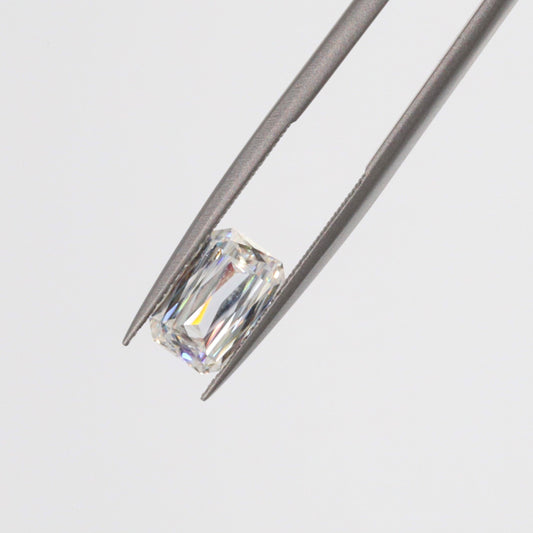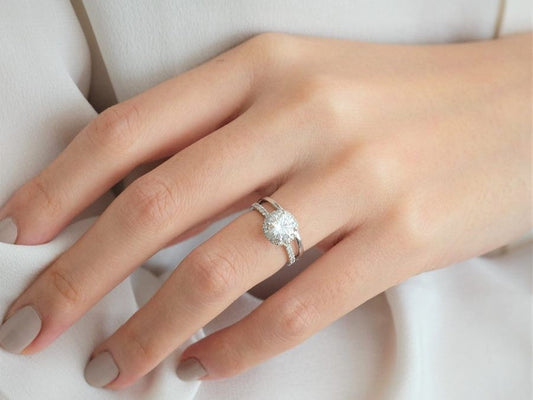Are you considering an engagement ring, wedding ring, or diamond necklace as your next big purchase?
Then consider lab-grown diamonds. These are gemstones that have entered the mainstream market because of their guaranteed quality and sustainability. It’s why an estimated 10% of all U.S. engagement ring sales now contain lab-grown diamonds.
In this blog, we look in-depth into lab-grown diamonds, their advantages, and the best place to buy manmade diamonds.
Lab-Grown Diamonds: An Overview
Everyone knows how diamonds are created. They are no more than pieces of crystallized carbon that have formed over billions of years after being exposed to high pressures and temperatures beneath the earth.
But today, we can replicate those conditions, and that’s why engineered diamonds exist. These diamonds enjoy the same characteristic crystal structure as their natural counterparts and use the same materials. It’s why a lab-created diamond is indistinguishable from a natural diamond without advanced equipment.
The only difference between a natural and manmade diamond is that the latter was created in a lab using the same conditions a piece of carbon would experience in the wild.
If you look at the best online lab-grown diamonds, you’ll also notice that no restrictions exist on the types of diamonds you can buy. Whether you want a flawless white or flashy pink diamond, you can make them in a lab.
And due to the lower costs, sustainability concerns, and ethical drive among the public, today, the lab-grown diamond market is worth $22.45 billion.
Lab-Grown Diamonds: How They’re Made
The best place to get lab-grown diamonds will always be transparent about where they sourced their diamonds and the process used to create them.
Today, China is the leading producer of synthetic diamonds, followed by India. Most laboratories utilize the High-Pressure, High-Temperature (HPHT) technique because of the perceived higher quality of the finished diamond. However, diamonds may also be made using the Chemical Vapor Deposition (CVD) technique.
Both methods are used to source gemstones by the best lab-grown diamond jewelry shops worldwide.
HPHT
The HPHT method is the closest to how a natural diamond is formed. Initially, a small diamond seed is embedded within a piece of carbon. A form of press is then used to pressurize the carbon to 1.5 million pounds per square inch. Simultaneously, the carbon is heated to 2,700 degrees Fahrenheit.
The pressure and heat combined will melt the carbon, and the new diamond will form around the initial seed. Once completed, the new diamond is cooled before being prepared for cutting and polishing.
CVD
The CVD method also begins with a small diamond seed. This seed is usually no more than 300 microns thick.
However, this is where the similarities end. The diamond seed is placed in a sealed chamber heated to 1,400 degrees Fahrenheit. It will then be filled with a carbon-rich gas, such as methane or hydrogen. Some laboratories may also use nitrogen to speed up the process, but most prefer to go slower due to nitrogen's propensity to yellow the diamond.
Once the gases have been injected, their chemical bonds will break and stick to the seed. The new diamond then gradually forms new layers as more gas is injected, and broken down, forming new chemical bonds with the growing diamond.
Treatments
In both cases, further heat treatments are used to achieve the desired characteristic of the finished diamond.
For example, boron treatments can create blue diamonds, whereas radiation treatments are employed to make pink diamonds. You can also form green diamonds using a nickel-infused treatment.
Only once the diamond reaches this stage is it ready for cutting, polishing, and grading.
How Long Does It Take to Create a Lab-Grown Diamond?
The best lab-grown diamond company knows that this isn’t a process to rush. A failure to follow proper quality control measures will inevitably lead to fractures within the diamond.
Generally, the time it takes depends on the type of diamond and the method. CVD-grown diamonds are faster but are viewed to be of lower quality. Likewise, growing a white diamond can take over two weeks to create a single carat, whereas a blue diamond can be grown in as little as five days.
The efficiency of both processes means that the market can be flooded with the finest quality diamonds in weeks, thus undercutting the mining industry.
Lab-Grown Diamonds: Jewelry You Can Feel Good About
Diamonds have symbolized love, wealth, and beauty for centuries. But there is always a dark side to this industry.
At the height of the civil war in Sierra Leone, an estimated 4% of diamonds were conflict diamonds. It has always left a bad taste in people’s mouths, but lab-grown diamonds offer an alternative that is already transforming the industry.
So, why should you feel good about lab-grown jewelry?
The Green Alternative
Diamond mining causes massive amounts of environmental damage worldwide. Some of the reasons why mined diamonds are so bad for the environment include:
- Enormous fossil fuel consumption
- Huge carbon emissions
- Waterway pollution
- Air pollution
Lab-grown diamonds require far less energy to create and remove the need to move thousands of tons of soil. This is why these diamonds are considered 100% vegan-friendly. It’s also one of the reasons even the best place to buy lab-grown diamonds can sell these stones for half the price of a mined diamond.
Better Quality
Look for the best place for lab-grown diamonds, and you’ll come across retailers talking about how synthetic diamonds offer the same quality as mined diamonds. This is false.
Synthetic diamonds actually offer greater purity than natural diamonds because they are not exposed to dirt or other imperfections while locked within inner Earth. Engineered diamonds are formed in optimal conditions using highly precise calibrations.
So, what do you get with a lab-grown diamond?
- Better overall quality
- Enhanced brightness
- Fewer internal and external flaws
- Increased whiteness
- Higher clarity
- Superior grading
There’s also the question of how these diamonds are extracted. Diamonds within the earth are exposed to dirt. But diamonds from the surface are mined using diesel and dynamite, which puts even more strain on the stone’s crystalline structure.
Manmade diamonds are never exposed to any of these pressures.
Lower Prices
Deciding where to buy manmade diamonds is one of the most time-consuming parts of buying a fine piece of jewelry. But regardless of where you buy, expect a discount of 40-50% on your lab-grown diamond. Generally, the larger the stone, the bigger the discount.
Why are they so affordable?
It’s all in the supply and demand. Before lab-grown diamonds, it was thought there was a minimal supply of these stones. Add in the immense cost of mining, and you have an expensive stone.
But since lab-grown diamonds can be made in weeks and don’t come with the same high production costs, they have driven overall prices down.
Known Origins
Do you want to know where your diamonds come from?
While official numbers reveal that the number of conflict diamonds has dropped, these are a gross underestimation of reality. Acts like the Kimberley Process to prevent diamonds of dubious quality only arrived in the early 21st century, meaning before this, there were no accurate methods to establish a diamond’s origins.
Moreover, the Kimberley Process is flawed. According to Time Magazine, it only applies the “blood diamond” definition to diamonds sold to fund a rebel movement seeking to overthrow a government.
It does not account for anything else, such as:
- Child labor
- Human rights violations
- Poor working conditions
And most of us would consider a diamond sold to fund a rebel movement just as bad as a diamond mined by a child working in appalling conditions.
In contrast, a lab-grown diamond has a spotless history, with all labs registered and certified. Plus, every diamond produced in this way is laser-inscribed with a unique number so that it can be traced back to where it was grown.
Factors to Consider When Buying Lab-Grown Diamonds
Like any diamond, cultured diamonds vary in quality, as do the jewelry stores selling them. Before making a purchase, it’s critical that you decide what’s important to you and weigh up your options.
Follow this buyer's guide before deciding the best place to buy lab-created diamonds.
What’s the Quality of the Stone?
The first step is to determine the quality of the diamond you want to buy. Grading is the same as mined diamonds and follows the familiar four C’s. We also recommend adding a fifth C to your deliberations when buying any diamond.
If you’re unfamiliar with the C’s of diamond purchasing, they are:
Cut
The diamond’s cut is what determines its shapes and facets. These two elements make your diamond sparkle whenever it reflects the light.
Popular cuts include:
- Round Brilliant – 57 facets
- Rectangular Emerald – 44 facets
- Square Princess – 50-58 facets
- Oval – 56 facets
- Slender Marquise – 58 facets
- Hybrid Pear – 58 facets
A diamond’s cut rating evaluates the skill of the person cutting it. With the right lab, high-quality cuts are easier than ever since they can use laser cutting tools.
Clarity
Clarity is a measure of purity. In other words, it measures whether there are any flaws. The clearer the diamond, the more valuable it becomes.
An internal flaw is an inclusion, whereas an external flaw is a blemish. In gemology, the scale begins from Included (I) to Flawless (FL), with ratings like Very, Very Slightly Included (VVS) in between.
Carat
Carat evaluates the weight of a diamond. In metric terms, a metric carat is equivalent to 200 milligrams. Every carat can be further subdivided into 100 points.
Beyond one carat, a diamond’s weight will be expressed in decimals, such as a 1.75-carat diamond. Naturally, the greater the carat, the higher the price.
Color
Diamonds are available in various colors, but gemologists generally split color into two categories: colorless/white and fancy.
Color grades require a high degree of experience and training to assign because the differences are so subtle. A single variation can make a massive difference to the quality of a diamond.
Characteristics like hue and intensity can drastically influence the quality and value of a stone.
The grading scale of the Gemological Institute of America (GIA) is the most common standard used within the industry. As a rule, all white diamonds are classified on a scale from D to Z, with the former indicating the highest quality and the latter indicating the lowest.
Note that in the past low-quality colored diamonds have become highly prized because of a fashion trend or a celebrity, so there are exceptions to this rule.
Conflict
Finally, we have the fifth “C,” which stands for Conflict. While not an official part of the grading scale, this is something that buyers are increasingly considering when purchasing any diamond.
However, while this may be an issue with natural diamonds, lab-grown diamonds have no ties to human rights violations, warzones, or unethical practices, meaning you always know that your jewelry is free of skeletons in the closet.
Moreover, all lab-grown diamonds receive a unique number, so any diamond can easily be tracked and traced.
Certification
With the various C’s in mind, you must be mindful of the authenticity of a particular rating. This is why you should always ask for a diamond’s official certification before paying the bill.
A GIA or IGI-certified lab-grown diamond is viewed as the minimum standard of authenticity. Accept nothing less.
Which Production Method Was Used?
HPHT and CVD synthesis are the only two methods in use to create a lab-grown diamond. While one is not objectively superior to the other, certain marks can indicate how a diamond was grown.
If a retailer cannot tell you which method was used, this is a red flag that they are not using a transparent supply chain.
Does the Stone Have an Undesirable Tint?
Without adequate heat treatments, stones produced by either artificial production method can display unwanted tints.
The most common tint from HPHT production is subtle blue. This is known as a blue nuance and can either be pale blue or grey. It’s an undesirable tint many jewelers will not accept for sale, which is also why they are among the cheapest manmade diamonds.
In contrast, CVD-grown diamonds may display a brown tint. This is a standard tint that appears in two-thirds of these diamonds. However, it can be limited by various heat treatments in post-production.
If you want to avoid tints entirely, look for a lab-grown diamond with color grades D, E, or F.
Does the Stone Have Phosphorescence?
Phosphorescence is an essential feature that will not be written on a lab-grown diamond’s production report. This phenomenon occurs when one of these diamonds is exposed to daylight. It appears as an orange glow and is viewed as a negative feature of these stones.
The orange glow can last as little as ten seconds, or it could last for several minutes. It occurs due to trace elements of nitrogen or boron within the diamond, which is evidence of impurity.
The best place to buy lab-grown diamonds will always be able to tell you about phosphorescence. If they cannot, it’s time to look elsewhere.
Is My Supplier Using Sustainable Practices?
As with any industry, lab-grown diamond suppliers vary in their commitments to sustainability. If this is a driving force for you, it is vital that you can trace a diamond back to its lab.
If you are concerned about fossil fuel usage, dig deeper with your vendor to determine where they get their diamonds from. All reputable jewelers will have a transparent supply chain.
What is My Budget?
Lab-grown diamonds are always more affordable than their natural alternatives. The coming of synthetic diamonds has enabled countless consumers to purchase and own a real diamond for the first time.
However, since manmade diamonds vary in quality and are graded along the same scales as mined diamonds, you will see a massive price difference. If you want to purchase a flawless synthetic diamond, it will cost far more than if you were purchasing a brown or yellow diamond.
This is where the importance of doing your research comes to the fore. Define your budget early and then create a shortlist of diamonds to avoid overspending. It also helps to have a because the best place to buy lab diamonds can provide tailored recommendations.
Gema&Co: The Best Place to Buy Lab-Grown Diamonds
Gema&Co aims to take diamonds in a new direction. We believe that overmarketed mined diamonds are unnecessary for purchasing a fine piece of engagement or wedding jewelry.
Our commitment to lab-grown diamonds symbolizes our desire to open the market and provide affordable gemstones without worrying about compromising on quality or style. With our transparent supply chains and sustainable practices, we work with the public to ensure they can feel great about purchasing a diamond for themselves or their significant other.
If you value style, sustainability, and prices you can afford, Gema&Co is the affordable online jeweler you can rely on. Browse our lab-grown diamond engagement ring collection to check out our latest exquisite additions.




